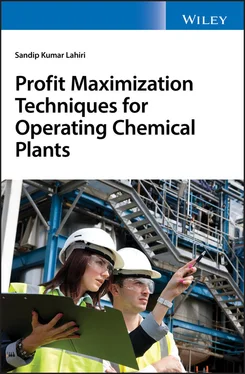283 266
284 267
285 268
286 269
287 270
288 271
289 272
290 273
291 274
292 275
293 276
294 277
295 278
296 279
297 280
298 281
299 282
300 283
301 284
302 285
303 286
304 287
305 288
306 289
307 290
308 291
309 292
310 293
311 294
312 295
313 296
314 297
315 298
316 299
317 300
318 301
319 302
320 303
321 304
322 305
323 306
324 307
325 309
326 310
327 311
328 312
329 313
330 314
331 315
332 316
333 317
334 318
335 319
336 320
337 321
338 322
339 323
340 324
341 325
342 326
343 327
344 328
345 329
346 330
347 331
348 332
349 333
350 334
351 335
352 336
353 337
354 338
355 339
356 340
357 341
358 342
359 343
360 344
361 345
362 346
363 347
364 348
365 349
366 350
367 351
368 352
369 353
370 354
371 355
372 356
373 357
374 358
375 359
376 360
377 361
378 362
379 363
380 364
381 365
382 366
383 367
384 368
385 369
386 370
387 371
388 373
389 374
390 375
391 376
392 377
393 378
Profit Maximization Techniques for Operating Chemical Plants
Sandip Kumar Lahiri
National Institute Of Technology, Durgapur, India

This edition first published 2020
© 2020 John Wiley & Sons Ltd
All rights reserved. No part of this publication may be reproduced, stored in a retrieval system, or transmitted, in any form or by any means, electronic, mechanical, photocopying, recording or otherwise, except as permitted by law. Advice on how to obtain permission to reuse material from this title is available at http://www.wiley.com/go/permissions.
The right of Sandip Kumar Lahiri to be identified as the author of this work has been asserted in accordance with law.
Registered Offices
John Wiley & Sons, Inc., 111 River Street, Hoboken, NJ 07030, USA
John Wiley & Sons Ltd, The Atrium, Southern Gate, Chichester, West Sussex, PO19 8SQ, UK
Editorial Office
John Wiley & Sons Ltd, The Atrium, Southern Gate, Chichester, West Sussex, PO19 8SQ, UK
For details of our global editorial offices, customer services, and more information about Wiley products visit us at www.wiley.com.
Wiley also publishes its books in a variety of electronic formats and by print‐on‐demand. Some content that appears in standard print versions of this book may not be available in other formats.
Limit of Liability/Disclaimer of Warranty
In view of ongoing research, equipment modifications, changes in governmental regulations, and the constant flow of information relating to the use of experimental reagents, equipment, and devices, the reader is urged to review and evaluate the information provided in the package insert or instructions for each chemical, piece of equipment, reagent, or device for, among other things, any changes in the instructions or indication of usage and for added warnings and precautions. While the publisher and authors have used their best efforts in preparing this work, they make no representations or warranties with respect to the accuracy or completeness of the contents of this work and specifically disclaim all warranties, including without limitation any implied warranties of merchantability or fitness for a particular purpose. No warranty may be created or extended by sales representatives, written sales materials or promotional statements for this work. The fact that an organization, website, or product is referred to in this work as a citation and/or potential source of further information does not mean that the publisher and authors endorse the information or services the organization, website, or product may provide or recommendations it may make. This work is sold with the understanding that the publisher is not engaged in rendering professional services. The advice and strategies contained herein may not be suitable for your situation. You should consult with a specialist where appropriate. Further, readers should be aware that websites listed in this work may have changed or disappeared between when this work was written and when it is read. Neither the publisher nor authors shall be liable for any loss of profit or any other commercial damages, including but not limited to special, incidental, consequential, or other damages.
Library of Congress Cataloging‐in‐Publication Data
Names: Lahiri, Sandip Kumar, 1970‐ author.
Title: Profit maximization techniques for operating chemical plants / Dr
Sandip Kumar Lahiri.
Description: First edition. | Hoboken, NJ : John Wiley & Sons, Inc., 2020.
| Includes bibliographical references and index.
Identifiers: LCCN 2019058766 (print) | LCCN 2019058767 (ebook) | ISBN
9781119532156 (hardback) | ISBN 9781119532217 (adobe pdf) | ISBN
9781119532170 (epub)
Subjects: LCSH: Chemical engineering--Cost effectiveness. | Engineering
economy. | Profit.
Classification: LCC TP155.2.C67 L34 2020 (print) | LCC TP155.2.C67
(ebook) | DDC 660.068/1--dc23
LC record available at https://lccn.loc.gov/2019058766
LC ebook record available at https://lccn.loc.gov/2019058767
Cover Design: Wiley
Cover Images: © David Burton/Getty Images, © Lightspring/Shutterstock
Dedicated to my Parents, wife Jinia and two lovely children Suchetona and Srijon
In chemical process industries there is an ongoing need to reduce the cost of production and increase the profit margin. Due to cut‐throat competition at the global level, the major chemical process industries are now competing to optimize raw material and utility consumption, to increase equipment and process performance, to reduce emissions, and to minimize pollution.
Profit maximization is the buzzword of today's chemical process industries. Profit maximization in running chemical plants itself is a huge challenge, which needs to be addressed by holistic vision and procedures. However, there are no dedicated books available to discuss basic concepts, provide practical methods, and explain industrial application procedures.
This book is written to fill this gap with the following people in mind: practicing process or chemical engineers, production engineers, supervisors, senior technicians working in chemical, petrochemical, pharmaceuticals, paper and pulp, oil and gas companies, and petroleum refinery across the globe. This book will also become very useful for large numbers of managers, general managers, top‐level senior executives, and senior technical service consultants, whose main jobs include strategic planning and implementation of various optimization projects to increase profit in chemical process industries. Undergraduate and postgraduate chemical engineering students and business students who want to pursue careers in the chemical field will also greatly benefit from this book. The book is aimed at providing practical tools to people who face challenges and wish to find opportunities for improving profit in running chemical plants. It aims to convey concepts, theories, and methods in a straightforward and practical manner.
Читать дальше













